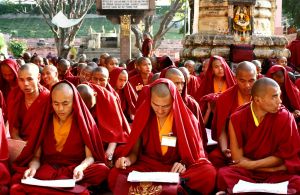What is the goal of Vajrayana?
What is the goal of Vajrayana?
Goal. The goal of spiritual practice within the Mahayana and Vajrayāna traditions is to become a Sammāsambuddha (fully awakened Buddha), those on this path are termed Bodhisattvas. As with the Mahayana, motivation is a vital component of Vajrayāna practice.
What are the three means in Vajrayana Buddhism?
Although the names are different, these three do not in any way differ from the Three Jewels. The Guru is the Budha [sic], the Yidam is the Dharma, and the Dakinis and Protectors are the Sangha. And on the innermost level, the Dharmakaya is the Buddha, the Sambhogakaya is the Dharma, and the Nirmanakaya is the Sangha.
Is Dalai Lama a Vajrayana?
The best known face of Tibetan Buddhism is the Dalai Lama, who has lived in exile in India since he fled Chinese occupation of his country in 1959. Tibetan Buddhism combines the essential teachings of Mahayana Buddhism with Tantric and Shamanic, and material from an ancient Tibetan religion called Bon.
Why is Vajrayana called the Diamond Vehicle
Sometimes, elements of tantra are found in other Mahayana schools as well. The term Vajrayana seems to have appeared about the 8th century. The vajra, a symbol adopted form Hinduism, originally signified a thunderbolt but came to mean “diamond” for its indestructibility and its power to cut through illusions.
How does Vajrayana Buddhism fight fire with fire?
How does Vajrayana Buddhism “fight fire with fire”? Vajrayana Buddhism “fights fire with fire” by harnessing the energy of desire and turning it against itself. The Dalai Lama is the spiritual leader of Vajrayana Buddhism. He is believed to be an incarnation of bodhisattva.
What does Theravada mean?
What is the difference between Vajrayana and Mahayana?
While Theravada Buddhists see the Mahayana as having strayed into some heterodox teachings from scriptures not derived from the original speech of the Buddha, and Mahayana Buddhist see themselves as having both the teachings of the earthly Buddha and the deeper and fuller teachings which come from the heavenly Buddhas …
Is Tibetan Buddhism Theravada or Mahayana?
Tibetan Buddhism evolved as a form of Mahāyāna Buddhism stemming from the latest stages of Indian Buddhism (which also included many Vajrayāna elements). It thus preserves many Indian Buddhist tantric practices of the post-Gupta Early Medieval period (500 to 1200 CE), along with numerous native Tibetan developments.
What is difference between Zen Buddhism and Tibetan?
The really short answer is this: Zen Buddhism is minimalist and Tibetan Buddhism is much more elaborate. Zen meditation is mainly about following the breath as well as emptying the mind. Tibetan Buddhism is more what we would think of as religious.
Is Zen a Buddhist?
Zen Buddhism is a mixture of Indian Mahayana Buddhism and Taoism. It began in China, spread to Korea and Japan, and became very popular in the West from the mid 20th century. The essence of Zen is attempting to understand the meaning of life directly, without being misled by logical thought or language.
Which branch of Buddhism is the most popular?
Indo-Tibetan Buddhism, the most widespread of these traditions, is practiced in Tibet, parts of North India, Nepal, Bhutan, China and Mongolia.
Where do Buddhist live in the world?
What are the traditions in Buddhism?
Widely observed practices include taking refuge in the Buddha, the Dharma and the Sangha, observance of moral precepts, Buddhist monasticism, Buddhist meditation, and the cultivation of the Paramitas (perfections, or virtues).
What do Buddhist Do When Someone Dies?
Buddhists generally favor cremation, but embalming is allowed as well. Families choose according to their personal preference. There are no rules governing when the burial or cremation takes place. Buddhist funeral rites are conducted on the morning of the burial/cremation ceremony.
Why do Buddhist monks wear orange?
Orange was chosen mainly because of the dye available at the time. The tradition stuck and orange is now the color of choice for Theravada Buddhist followers in Southeast Asia, as opposed to a maroon color for Tibetan monks. The robes themselves are meant to symbolize simplicity and detachment of materialism.
How long do Buddhist monks meditate?
one hour
What do monks do in a day?
What do monks do all day? They do the things that make them communal — Mass, prayer, reflection, service. They also do the things that make them unique — exercise, collecting, composing, cooking.
How long do Buddhist monks sleep?
Buddhist monks or yogis sometimes participate in long retreats with very little sleep and sit upright in a meditation posture for 24 hours a day for considerable periods of time. In that situation, the sleep is very light and one never goes very deeply into unconscious states.
Source
[[1]]
